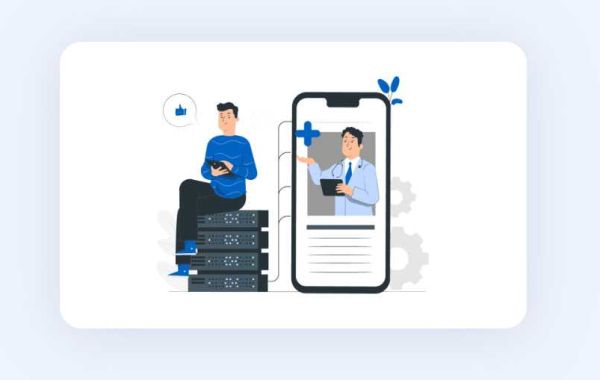In recent years, telemedicine has emerged as a groundbreaking solution, revolutionizing the way healthcare services are delivered and accessed. With the advent of advanced technologies, the development of telemedicine applications has become increasingly prevalent, offering a myriad of benefits to both healthcare providers and patients alike. In this comprehensive guide, we delve deep into the realm of telemedicine application development, exploring its intricacies, challenges, and future prospects.
Understanding Telemedicine
Telemedicine encompasses the provision of healthcare services remotely, utilizing telecommunications technology. This includes virtual consultations, remote monitoring, teleconferencing, and electronic health records (EHR) management. The primary objective of telemedicine is to facilitate access to healthcare services, particularly for individuals residing in remote areas or those with limited mobility.
The Importance of Telemedicine Applications
Telemedicine applications play a pivotal role in extending the reach of healthcare services beyond traditional clinical settings. These applications enable patients to consult healthcare professionals from the comfort of their homes, eliminating the need for physical visits to hospitals or clinics. Moreover, telemedicine applications enhance convenience, reduce waiting times, and lower healthcare costs, making healthcare more accessible and affordable for all.
Key Features of Telemedicine Applications
Seamless Appointment Scheduling
One of the essential features of telemedicine applications is seamless appointment scheduling functionality. Users should be able to book appointments with healthcare providers effortlessly, choosing their preferred time slots and specialties.
Secure Video Conferencing
Secure video conferencing capabilities are integral to telemedicine applications, facilitating real-time consultations between patients and healthcare professionals. End-to-end encryption ensures the privacy and confidentiality of sensitive medical information.
Electronic Health Records (EHR) Integration
Telemedicine applications often integrate electronic health records (EHR) systems, allowing healthcare providers to access patients' medical histories, diagnostic reports, and treatment plans remotely. This ensures continuity of care and enables informed decision-making during virtual consultations.
Remote Monitoring Tools
Advanced telemedicine applications incorporate remote monitoring tools, enabling healthcare providers to remotely monitor patients' vital signs, medication adherence, and disease progression. This proactive approach to healthcare management enhances patient outcomes and reduces the risk of complications.
In-App Prescription Services
Some telemedicine applications offer in-app prescription services, allowing healthcare providers to prescribe medications electronically and facilitate seamless pharmacy integration for medication delivery or pickup. This enhances medication adherence and improves overall treatment compliance.
Challenges in Telemedicine Application Development
While telemedicine offers immense potential, its development is not without challenges. Some of the key challenges include:
Regulatory Compliance
Telemedicine applications must comply with stringent regulatory requirements, including data privacy laws, healthcare regulations, and licensure requirements for healthcare providers. Ensuring compliance with these regulations is essential to avoid legal repercussions and maintain patient trust.
Technical Complexity
The development of telemedicine applications involves complex technical considerations, including platform compatibility, scalability, interoperability, and security. Addressing these technical challenges requires expertise in healthcare IT, software development, and cybersecurity.
User Adoption and Engagement
Driving user adoption and engagement is critical for the success of telemedicine applications. Educating patients and healthcare providers about the benefits of telemedicine, addressing concerns related to privacy and security, and designing user-friendly interfaces are essential strategies to promote adoption and usage.
Integration with Existing Healthcare Systems
Integrating telemedicine applications with existing healthcare systems, such as electronic health records (EHR) platforms and medical billing systems, can be challenging due to interoperability issues and legacy infrastructure. Seamless integration is necessary to ensure data continuity and workflow efficiency.
Future Trends in Telemedicine Application Development
As technology continues to evolve, the future of telemedicine application development holds immense promise. Some emerging trends and innovations in this field include:
Artificial Intelligence (AI) and Machine Learning (ML)
The integration of artificial intelligence (AI) and machine learning (ML) algorithms into telemedicine applications enables advanced analytics, predictive modeling, and personalized healthcare interventions. AI-driven chatbots and virtual assistants enhance patient engagement and automate routine tasks, improving overall efficiency.
Wearable Health Technology
Wearable health technology, such as smartwatches, fitness trackers, and biosensors, is increasingly being integrated with telemedicine applications to enable continuous remote monitoring of patients' health metrics. These wearable devices provide real-time data insights, allowing healthcare providers to monitor patients' health status remotely and intervene proactively.
Augmented Reality (AR) and Virtual Reality (VR)
Augmented reality (AR) and virtual reality (VR) technologies are transforming the telemedicine landscape, enabling immersive virtual consultations, medical training simulations, and patient education experiences. AR and VR applications enhance the quality of care, facilitate surgical planning, and improve medical training outcomes.
Blockchain Technology
Blockchain technology holds the potential to revolutionize telemedicine by enhancing data security, interoperability, and transparency. Blockchain-based solutions enable secure storage and sharing of medical records, facilitate peer-to-peer transactions, and ensure tamper-proof audit trails, thereby enhancing trust and privacy in telemedicine transactions.
Conclusion
Telemedicine application development represents a significant paradigm shift in the delivery of healthcare services, offering unprecedented convenience, accessibility, and efficiency. By leveraging advanced technologies and innovative solutions, telemedicine applications have the power to transform the healthcare landscape, improving patient outcomes and reducing healthcare disparities. As we embrace the future of telemedicine, it is imperative to address the challenges and seize the opportunities to create a more equitable and sustainable healthcare ecosystem.








